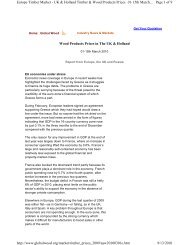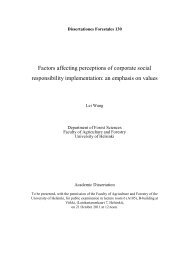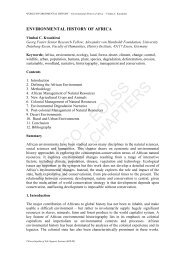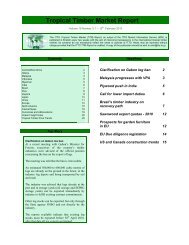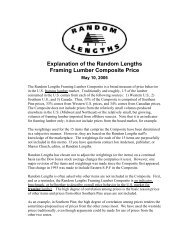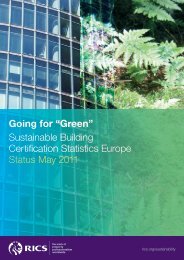ICT and e-Business in the Pulp, Paper and Paper ... - empirica
ICT and e-Business in the Pulp, Paper and Paper ... - empirica
ICT and e-Business in the Pulp, Paper and Paper ... - empirica
Create successful ePaper yourself
Turn your PDF publications into a flip-book with our unique Google optimized e-Paper software.
<strong>Pulp</strong>, paper <strong>and</strong> paper products<br />
In parallel to papiNet®, GUSI is be<strong>in</strong>g promoted by <strong>the</strong> consumer goods <strong>in</strong>dustry as a<br />
st<strong>and</strong>ard for e-bus<strong>in</strong>ess with <strong>the</strong>ir suppliers, <strong>in</strong>clud<strong>in</strong>g <strong>the</strong> packag<strong>in</strong>g <strong>in</strong>dustry.<br />
<strong>ICT</strong> as a driver of improved process efficiency<br />
The <strong>in</strong>tegration of digital <strong>in</strong>formation flows, dur<strong>in</strong>g all phases of B2B transactions<br />
(<strong>in</strong>clud<strong>in</strong>g order<strong>in</strong>g, <strong>in</strong>voic<strong>in</strong>g <strong>and</strong> payments), with production management <strong>and</strong> logistics<br />
has significantly facilitated bus<strong>in</strong>ess processes between P&P producers <strong>and</strong> <strong>the</strong>ir<br />
suppliers <strong>and</strong> customers (see Section 4.2). Effects tend to be most significant if both<br />
trad<strong>in</strong>g partners have an ERP system as <strong>the</strong> ma<strong>in</strong> 'hub' for automat<strong>in</strong>g processes.<br />
The ma<strong>in</strong> effects of <strong>ICT</strong> adoption with regard to process efficiency noted from case<br />
studies <strong>and</strong> <strong>in</strong>terviews with companies are:<br />
acceleration of processes;<br />
<strong>in</strong>creased <strong>in</strong>ternal transparency of processes; <strong>and</strong><br />
improved use of production capacity.<br />
Deployment <strong>and</strong> implications of RFID<br />
Manufacturers of pulp <strong>and</strong> paper <strong>in</strong>creas<strong>in</strong>gly use RFID for warehouse <strong>and</strong> <strong>in</strong>ventory<br />
management. Early experience of RFID implementation demonstrates that it can help<br />
companies to l<strong>in</strong>k order<strong>in</strong>g, production <strong>and</strong> logistics processes, <strong>the</strong>reby streaml<strong>in</strong><strong>in</strong>g <strong>the</strong>ir<br />
supply cha<strong>in</strong> <strong>and</strong> reduc<strong>in</strong>g lead times.<br />
However, <strong>the</strong> benefits of <strong>the</strong> use of RFID over barcode technology, for <strong>the</strong> same<br />
purposes, are not yet obvious. In particular, <strong>the</strong> total costs for RFID implementation<br />
are still considerable. Therefore, adoption strategies differ: some P&P companies choose<br />
to be early adopters, while o<strong>the</strong>rs deliberately opt for a “wait-<strong>and</strong>-see” strategy.<br />
In <strong>the</strong> convert<strong>in</strong>g <strong>in</strong>dustry, compliance with customer dem<strong>and</strong> (<strong>in</strong> particular from large<br />
retailers <strong>and</strong> <strong>the</strong> consumer goods <strong>in</strong>dustry) is <strong>the</strong> most important driver for RFID adoption<br />
(see Section 4.3).<br />
<strong>ICT</strong> impact on paper consumption<br />
Although, <strong>in</strong> some <strong>in</strong>stances, <strong>the</strong> adoption of <strong>ICT</strong> by households <strong>and</strong> bus<strong>in</strong>esses leads to<br />
substitution of paper or paper-based products, <strong>the</strong> net impact of all factors that have an<br />
<strong>in</strong>fluence <strong>in</strong> this respect results <strong>in</strong> a cont<strong>in</strong>ued growth <strong>in</strong> paper dem<strong>and</strong> <strong>and</strong> consumption<br />
(see Section 4.4).<br />
Substitution effects are most significant <strong>in</strong> <strong>the</strong> daily <strong>and</strong> weekly newspaper markets,<br />
where a large proportion of classified advertis<strong>in</strong>g is already migrat<strong>in</strong>g to <strong>the</strong> <strong>in</strong>ternet.<br />
The average volume of newspapers as well as <strong>the</strong>ir total circulation are decreas<strong>in</strong>g.<br />
However, a projection of figures on paper consumption <strong>in</strong> Europe s<strong>in</strong>ce <strong>the</strong> mid 1990s<br />
<strong>in</strong>dicates a moderate growth even <strong>in</strong> advanced economies.<br />
Overall bus<strong>in</strong>ess impact<br />
Impact at company level<br />
<strong>ICT</strong> <strong>and</strong> e-bus<strong>in</strong>ess have a considerable impact on work processes <strong>and</strong> on bus<strong>in</strong>ess<br />
process efficiency <strong>in</strong> companies from <strong>the</strong> P&P <strong>in</strong>dustry. Companies <strong>in</strong>creas<strong>in</strong>gly use<br />
7



